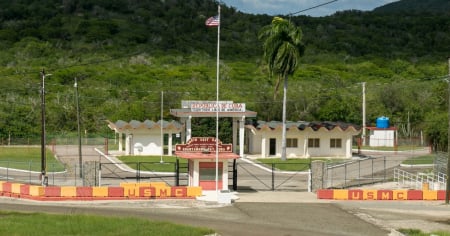The United States government has begun to implement a plan initiated by the Donald Trump administration to relocate up to 30,000 migrants to the Guantanamo Naval Base in Cuba. This measure aims to relieve the pressure on detention centers within the United States and will focus on housing irregular migrants accused of crimes.
The U.S. Secretary of Defense, Pete Hegseth, reported on Thursday that his agency is coordinating efforts to establish an area within the base for this purpose.
"We are willing to support the president's directive to ensure that we have a place for violent illegal offenders when they are deported from the country," Hegseth stated in a video posted on his social media.
The executive order, signed by Trump on Wednesday, instructs the Department of Defense and the Department of Homeland Security to “take all appropriate measures to expand the Migratory Operations Center at the Guantanamo Bay Naval Station to its maximum capacity to provide additional detention space for high-priority foreign criminals”.
During the signing of the document, Trump stated that the U.S. has about 30,000 beds in Guantanamo to accommodate those he considers "the worst illegal criminal immigrants who pose a threat to the American people".
The White House justifies the measure as a strategy to manage the migration crisis, driven by the deportation plan implemented by the current administration.
"Some of them are so dangerous that we don't even trust the countries to hold them because we don't want them to return, so we are going to send them to Guantánamo. This will double our capacity immediately, right? And it's difficult. It's a hard place to get out of. Today's signatures bring us one step closer to eradicating the scourge of migratory crime in our communities once and for all," they stated.
The Cuban government has described the decision as a "brutality". The leader, Miguel Díaz-Canel, stated on his social media: "In an act of brutality, the new U.S. government announces the incarceration of thousands of migrants it forcibly expels in the Guantanamo Naval Base, located in illegally occupied Cuban territory, placing them next to the well-known torture and illegal detention prisons."
Also, the Cuban Foreign Minister, Bruno Rodríguez, spoke out on the matter, stating that "the decision of the U.S. government to imprison migrants at the Naval Base in Guantánamo, an area where it created torture and indefinite detention centers, shows contempt for human dignity and International Law".
Rodríguez recalled that this piece of land at the eastern end of the island is a "territory of Cuba illegally occupied outside the jurisdiction of U.S. courts."
The Guantanamo Naval Base is a territory controlled by the United States in the southeastern part of Cuba. It is located in Guantanamo Bay and covers approximately 117 km². Its history is marked by geopolitical disputes, its use as a detention center, and its influence on relations between Cuba and the U.S.
In 1903, the U.S. and the Cuban government signed a perpetual lease of the base for $4,085 annually, through the Cuban-American Treaty. The agreement was reaffirmed in 1934 with the Platt Amendment, but can only be revoked if both parties agree.
Since 1959, Cuba has regarded the base as illegally occupied territory and refuses to accept lease payments.
The base has been used for multiple military purposes, but since 2002 it became notable for housing the Guantanamo prison, where the U.S. has detained alleged terrorists following the attacks of September 11, 2001.
The use of torture and indefinite detention has been reported, leading to criticism from international organizations and human rights groups.
Despite the efforts by various administrations to close the prison, it remains operational with a reduced population of detainees.
Frequently Asked Questions about Trump's Immigration Plan and the Use of Guantánamo
What is the objective of Trump's plan to send migrants to Guantánamo?
The main objective of the plan is to relieve pressure on detention centers in the U.S. by transferring migrants accused of crimes to the Guantanamo Naval Base. The aim is to manage the migration crisis and house foreigners deemed a high priority for deportation.
How has the Cuban government reacted to this plan?
The Cuban government has described the decision as "brutality." Cuban authorities criticize the use of the Guantanamo Naval Base, which they consider illegally occupied territory, for imprisoning migrants expelled from the U.S., emphasizing that this demonstrates a disregard for human rights and international law.
What is the Laken Riley Act mentioned in the context of the immigration plan?
The Laken Riley Act is a law aimed at strengthening the control of illegal immigration in the U.S. Named in honor of a victim of a crime committed by an illegal immigrant, this law allows the detention and deportation of immigrants accused of serious crimes, even before a judicial conviction, and is part of the legal framework for the plan to relocate migrants to Guantánamo.
What is the history of detainees at Guantanamo Naval Base?
The Guantanamo Naval Base has previously been used as a detention center in the context of the war on terror. Since 2002, it has housed alleged terrorists, generating criticism for the use of torture and indefinite detention. The base has been a point of conflict in Cuba-U.S. relations, being considered by Cuba as illegally occupied territory.
Filed under:
